Flamethrower tank Pz.Kpfw.III (Fl), Germany
In the summer of 1942, the battle of Stalingrad began, during which the troops had to fight in the conditions of urban development. Until a certain time, the German army tried to use the existing weapons, but in the future there was a proposal to create new systems. In November, 42, based on the results of the first months of urban battles, it was decided to return to the subject of flamethrower tanks. The main drawback of this technique, which limited its effectiveness on the battlefields, was the low range of throwing fire mixture. In an urban setting, however, the firing range of no more than 40-50 m could be sufficient.
Several companies were involved in the development of the new project and the subsequent construction of flamethrowing tanks. At the same time, Wegmann was appointed as the main contractor, which was to not only ensure the development of new equipment, but also set up production of mass-produced machines. The project also involved several other enterprises whose task was the production of individual components.
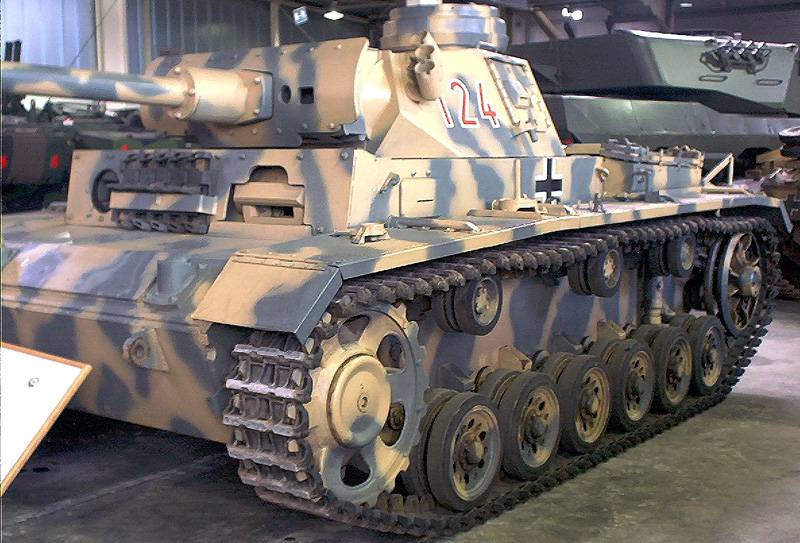
The only surviving Pz.Kpfw.III (Fl). Photo of Wikimedia Commons
The Pz.Kpfw.III serial medium tank was chosen as the base for a promising combat vehicle with flame-throwing weapons, which led to the appearance of the corresponding designation Pz.Kpfw.III (Fl) or Flammpanzer III. The selected tank was actively used by German troops and had acceptable characteristics. In addition, there was already extensive experience in the construction of various special equipment on the basis of such a tank, which, to a certain extent, facilitated the development of a new project, putting the car into a series and subsequent operation. Serial flamethrower tanks planned to build on the basis of machines Pz.Kpfw.III modification "M".
The new design of the flamethrower tank proposed to expose the base machine some alterations with the withdrawal of some units and the installation of others. In particular, the flamethrower of the new model was to be installed in the place of regular artillery weapons. The internal volumes of the fighting compartment, respectively, were released to accommodate the fire tanks and other units of the new weapons. Such proposals required processing of some parts of the base tank, at the same time allowing the use of part of the units in their original form.
The chosen method of modernization of the serial tank allowed to keep the existing hull, making minimal changes to its design. The Pz.Kpfw.III (Fl) was supposed to maintain a welded armored body with protection from 50 mm (forehead) to 10 mm (roof). In addition, in the new project it was proposed to use additional reservations. Additional sheets 30 mm thick should have been fixed on the frontal details of the car body. Taking into account the main features of the combat work of flamethrowing tanks, such modernization allowed significantly increasing the survivability of the machine.
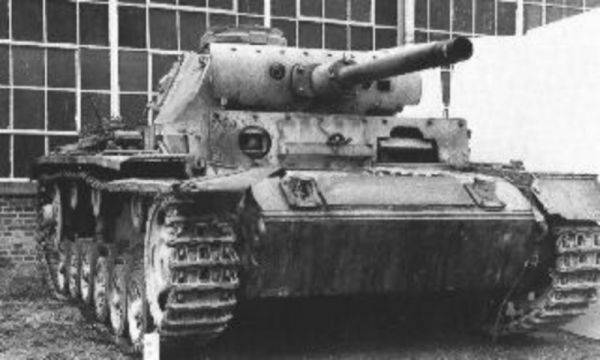
General view of the car. Photo Aviarmor.net
The layout of the body, in general, remained the same. Under the protection of frontal sheets there was a compartment with transmission units, behind which the control compartment was located. The upgraded fighting compartment with the new equipment was placed in the center of the hull. Feed was given under the engine. In the course of modernization, only the central compartment of the corps, in which the combat compartment was located, was actually subjected to modifications.
The project of modernization of serial tanks meant the preservation of the existing power plant and transmission. For this reason, a flamethrower was supposed to keep the Maybach HL 120TRM engine with 300 horsepower. Used six-speed gearbox. The transmission transmitted torque to the drive wheels located in front of the hull.
In order to simplify production, the new flamethrower tank retained the chassis of the base machine on the basis of six road wheels with an individual torsion bar suspension on each side. The tank received front drive and rear guide wheels. Also provided for three supporting rollers on each side.
It was proposed to place all the units of the flamethrower inside the modified fighting compartment. The tank of the basic design lost 50-mm guns and styling for its shells. In addition, crew seats were removed from the turret, with the exception of the commander’s. The construction of the tower itself was not finalized. The turret protection was provided by a frontal sheet 57 mm thick and 30 mm wide. In addition, an armored mask was maintained for additional protection.
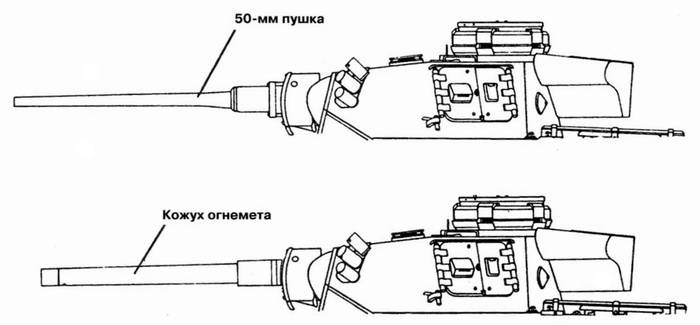
The differences of the towers of the base tank and flamethrowing machine. Figure Tehnikapobedy.ru
Instead of a gun on the modified mounts, it was proposed to install a flamethrower hoses. This device had a caliber 14,5 mm, sufficient to properly emit the right amount of fire mixture. In this case, it was proposed to cover the hoses with a metal casing of a larger "caliber" that imitated a gun. Thus, the tubular flamethrower unit was placed inside a one and a half meter protective casing. The turret rotation mechanism allowed shooting in any direction, the elevation angles varied from -8 ° to + 20 °.
At the place of laying for artillery shells inside the fighting compartment they placed two tanks for the storage of fire mixture with a total volume of 1000 l. The tanks were equipped with double walls, between which water was supposed to circulate from the engine cooling system. Combining the cooling system with tanks allowed to warm up the mixture before use to optimum temperatures. In addition, there was a pipeline connecting the cooling of the engine with the fire hose. Before firing, the barrel of the latter should also be heated to avoid the formation of plugs from thickened fire mixture. According to the calculations of the authors of the project, a flamethrower tank Pz.Kpfw.III (Fl) could shoot at ambient temperatures up to -22 ° C. It took about five minutes to preheat the tanks and the fire engine before firing.
Ejection of the mixture from the flamethrower was to be carried out using compressed air, for which a special compressor was introduced into the weapon system. As its basis was used motorcycle engine company DKW power 3 hp During the shot, a pressure supply of the order of 15 MPa, sufficient for the correct discharge of the liquid in the direction of the target, should have appeared in the fire supply system. For ignition, an electrical system mounted on the hoses was used.
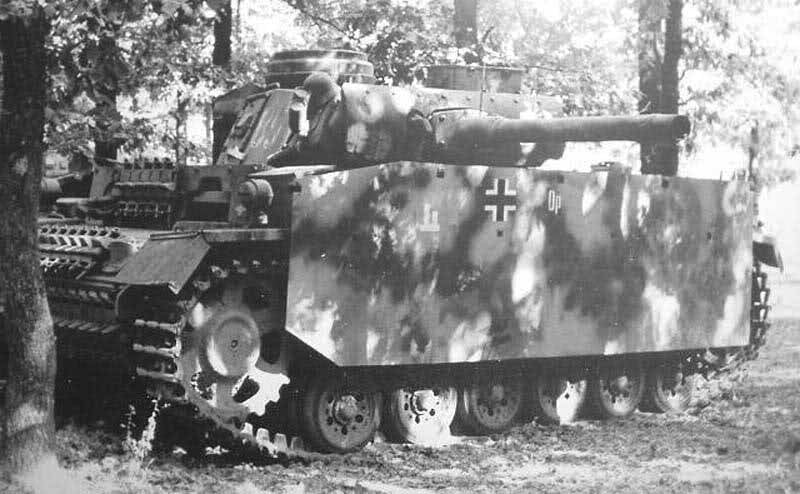
Flamethrower tank with extra protection. Photo Aviarmor.net
According to reports, the flamethrower of the new tank could operate in two modes. The first implied a volley of length 1 s, in which 8 l firefire was thrown. In this case, the 1000-liter "ammunition" was enough for 125 shots. It also provided for the maintenance of two-second volleys using the 12,5 liter mix in each. At the same time, an increased consumption of the mixture led to a reduction in the possible number of shots to 80. The pressure in the flamethrower made it possible to throw the fire mixture at a distance of up to 50-55 m. With a fair wind or difference in height between the tank and the target, the maximum firing range could reach 55-60 m.
During the rework, the base tank was supposed to lose the main gun, but the machine guns remained in place. One MG 34 machine gun was supposed to remain in a twin installation with a flamethrower, and the second, as before, was attached to the embrasure of the frontal hull plate. The total ammunition of two machine guns was 3750 cartridges. Also, the flamethrower tank Flammpanzer III received two built smoke grenade launchers on the cheekbones of the tower. Given the intended approach to the enemy for a minimum distance, the machine needed additional means of masking.
The crew of the base tank consisted of five people, while the flamethrower version had to be controlled by only three. In front of the hull, in the department of management, were placed the driver-mechanic (left) and the gunner-radio operator (right). They had their own hatches in the roof of the hull and had the opportunity to monitor the situation with the help of viewing devices. At the same time, the radio operator had to keep in touch with other crews with the help of the FuG 5 radio station (on the commander’s tanks — FuG 5 and FuG 2), as well as control the front machine gun.
Watch the situation on the battlefield, search for targets and use a flamethrower should have been the commander-gunner, located on a single workplace in the fighting compartment. With the help of existing optical devices, the commander had to find targets, his duties also included shooting from a flamethrower and machine gun, as well as performing various operations to service the main weapon.
Due to the dismantling of one equipment and the installation of another, the flamethrower tank of the new model did not differ much in size and weight from the base machine. The length, taking into account the hose and its casing, was 6,4 m, the width did not exceed 3 m, the height - 2,5 m. The modernization led to some increase in the combat weight. So, Pz.Kpfw.III Ausf.M weighed 22,7 t, while its flamethrower modification - 23 t.
Saving the main weight parameters and the lack of modifications of the power plant did not lead to a change in the mobility of the machine. The maximum speed of the flamethrower tank was 40 km / h, power reserve - up to 150 km. The possibility of climbing on slopes and walls, as well as overcoming shallow water barriers ford was preserved.
The first experienced flamethrower tank of the new model was assembled and released for testing in January 1943. It is noteworthy that by this time the German group in Stalingrad had already been taken around, and before its surrender there were only a few days left. Nevertheless, the development of the project created by the results of the first stages of the Battle of Stalingrad, continued. Failures on the Eastern Front did not lead to a halt in work.
During the ground tests at the beginning of 1943, it was found that the new flamethrower tank Pz.Kpfw.III (Fl) fully complies with the requirements and can be adopted. In early February, the car was officially put into service, and then started mass production. The first order for flamethrowing tanks meant the assembly and supply of hundreds of machines.
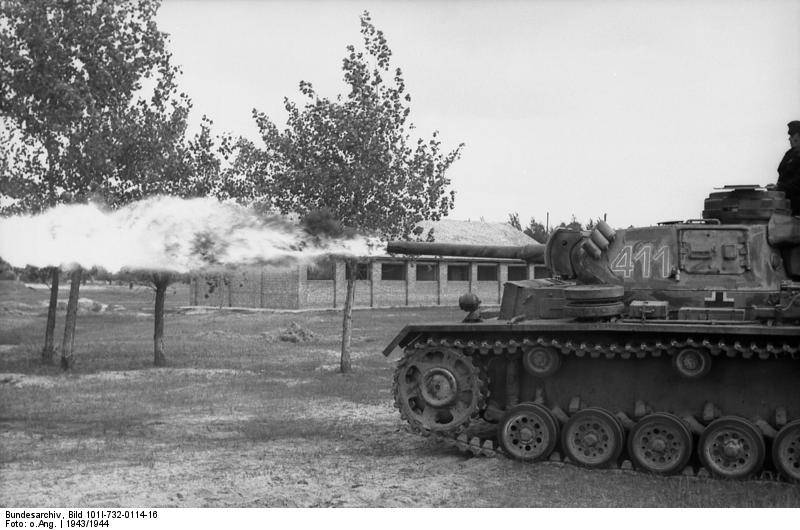
Use flamethrower. Photo of Wikimedia Commons
As early as February 1943, the Wegmann company received from the MIAG plant the required 100 medium tanks Pz.Kpfw.III Ausf.M, which were soon equipped with new equipment. The order was fully completed in April of the same year. According to some reports, further assembly of flamethrowing tanks could continue, but this did not happen. The troops received only a hundred of these machines.
In the troops, flamethrower tanks were reduced to platoons of seven vehicles each. Such flamethrower platoons were transferred to the maintenance of tank regiments, which required support in certain operations. According to reports, by the end of 1943, the Flammpanzer III flamethrower units were part of the 1, 6, 11, 14, and 24 tank divisions that fought on the territory of the Soviet Union. In addition, a number of such machines received the division Großdeutschland. Also flamethrower tanks were delivered 16-th and 26-th tank divisions stationed in Italy.
During the battles, new flamethrower tanks showed mixed results. Within the settlements, which are characterized by small distances of the battle, this technique showed a high efficiency of combat work. In addition, flamethrowing and machine-gun weapons made it possible to deal with manpower and unprotected equipment. A characteristic feature of Pz.Kpfw.III (Fl), like other flame-throwing tanks, was the psychological impact on the enemy soldiers. The streams of fire produced by armored vehicles looked extremely frightening and had a negative effect on the fighting spirit.
However, flamethrower tanks had such an effect only on infantry not reinforced by artillery or tanks. The characteristics of the Soviet tank and field guns made it possible to hit tanks Pz.Kpfw.III (Fl) long before they reached the distance of the response fire from a flamethrower. A successful hit, in turn, led to the ignition of the fire mixture, which left the car and its crew no chance of survival. In addition, the death of tankers led to a drop in the morale of their colleagues. Thus, the combat work of flamethrower tanks, despite some positive features, was associated with the highest risks.
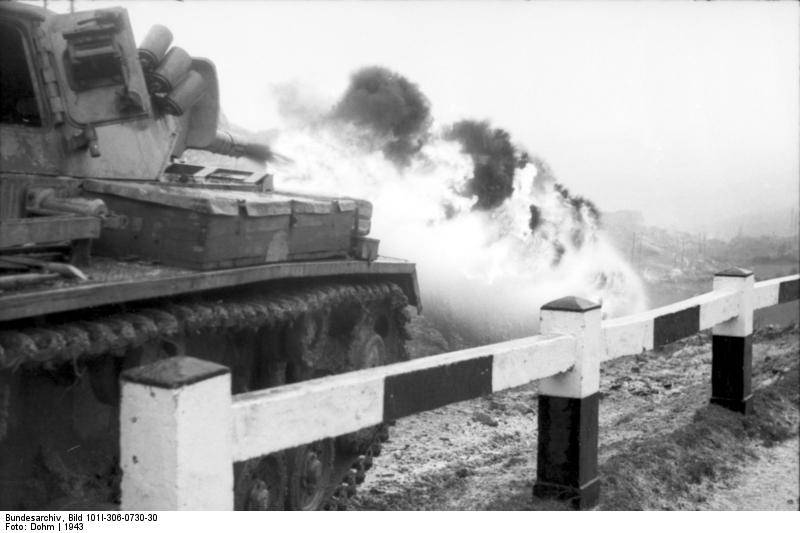
The serial Flammpanzer III is shooting. Photo of Wikimedia Commons
According to the results of the first months of use in the troops, Pz.Kpfw.III (Fl) flamethrower tanks were considered ineffective. The existing increase in characteristics in comparison with the previous technique of a similar purpose could not compensate for the shortcomings inherent in the concept of the flamethrower tank itself. Further mass operation of the Flammpanzer III tanks was considered inexpedient.
At the beginning of 1944, an order appeared to restructure the remaining Pz.Kpfw.III (Fl) vehicles into standard tanks with cannon armament. It is known that such a "reverse" upgrades were 35 tanks. At the same time, a number of flamethrowing machines were proposed to be repaired and left in service. By November 44-th ten tanks were repaired and were reduced to the 351-th flamethrower tank company. The remaining equipment of this model, apparently, was destroyed in battles or became a trophy of the enemy.
It is known that the 351-I flamethrower tank company continued to fight almost until the very end of the fighting in Europe. At the time of the surrender of Germany, this unit was part of the Sudetenland army group. In connection with the end of the war, the company’s equipment was handed over to the winners as trophies.
After the end of World War II in Europe, the need for flamethrowing tanks of existing types disappeared. Because of this, all remaining Pz.Kpfw.III cars (Fl) were disposed of as unnecessary. Until our time, lived only one sample of such technology. At one time, this car fought on the territory of Italy and was captured by American troops. Soon the trophy was taken to the Aberdeen testing ground. Later, the car was transferred to one of the German museums, where it still remains.
Based on:
http://armor.kiev.ua/
http://mg-tank.ru/
http://aviarmor.net/
http://tehnikapobedy.ru/
Chamberlain P., Doyle H. Complete reference book of German tanks and self-propelled guns of the Second World War. - M .: AST: Astrel, 2008.
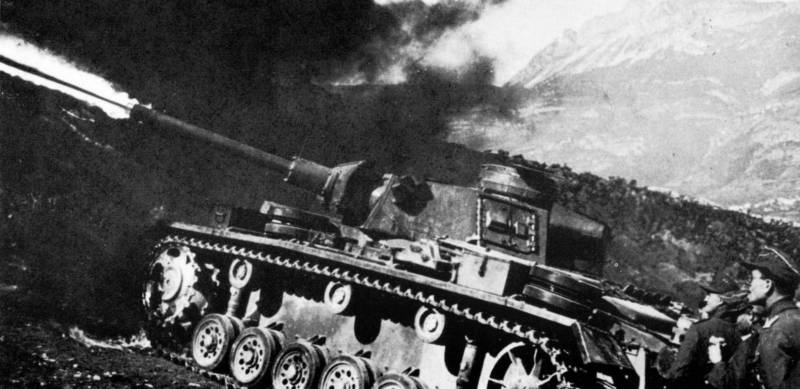
Information